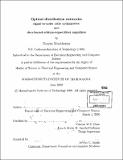Optical distribution networks : signal-to-noise ratio optimization and distributed erbium-doped fiber amplifiers
Author(s)
Mookherjea, Shayan, 1977-
DownloadFull printable version (5.189Mb)
Other Contributors
Massachusetts Institute of Technology. Dept. of Electrical Engineering and Computer Science.
Advisor
Vincent W.S. Chan.
Terms of use
Metadata
Show full item recordAbstract
Two important issues related to the use of remotely-pumped erbium-doped fiber amplifiers in optical distribution networks are analyzed. We investigate the optimal allocation of gain and loss among the stages of a lumped amplifier chain, using the concepts of a Nash solution and Pareto optimality. The propagation of optical channels along an erbium-doped fiber is derived from basic physical considerations, and compared with the well-known Desurvire model. We demonstrate a simple method of constructing bus distribution networks, but this approach is particularly sensitive to the numerical values of the parameters. A second approach is then discussed, extending the analysis of Sun et al. from ab-initio principles to model the effect of detectors (users) along a distribution network. Theoretical closed-form results indicate that the number of optical receivers that can be supported using this scheme is at least two orders of magnitude higher than without optical amplification. Finally, we analyze the effect of dynamic perturbations in the power that is extracted at the receivers. Though our focus is on bus networks, we also discuss tree distribution networks as extensions of the basic models. Our results have implications on the architecture of optical distribution networks.
Description
Thesis (S.M.)--Massachusetts Institute of Technology, Dept. of Electrical Engineering and Computer Science, 2000. Includes bibliographical references (leaves [149]-151) and index.
Date issued
2000Department
Massachusetts Institute of Technology. Department of Electrical Engineering and Computer SciencePublisher
Massachusetts Institute of Technology
Keywords
Electrical Engineering and Computer Science.